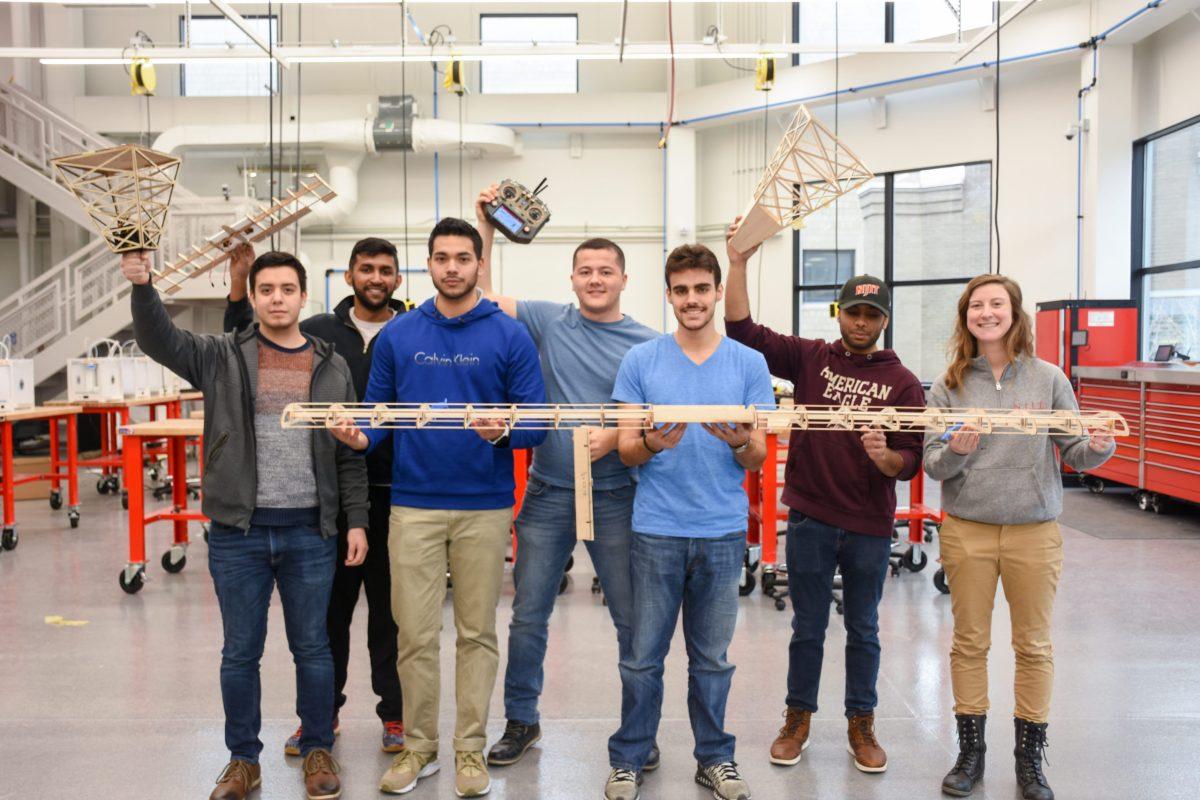[ngg_images source=”galleries” container_ids=”52″ display_type=”photocrati-nextgen_basic_slideshow” gallery_width=”600″ gallery_height=”400″ cycle_effect=”fade” cycle_interval=”3″ show_thumbnail_link=”0″ thumbnail_link_text=”[Show picture list]” order_by=”sortorder” order_direction=”ASC” returns=”included” maximum_entity_count=”500″]
SAE Aero Design (“regular class”) requires competing teams to build an aircraft from scratch, fly a 360 circuit and account for passengers and luggage aboard the flight. For the flight portion of the competition, each plane must take-off and land safely so that the “passengers”, which are tennis balls secured in placeholders, stay in place. Scoring is primarily based on how many tennis balls are intact upon landing. A written, detailed report is submitted and graded ahead of time, and the third and final component is a 10-minute presentation at the competition venue.
There are not many design restrictions: the wingspan cannot be over 12 feet and the entire aircraft must weigh under 55 pounds. The rest of the design choices, airfoil choices, dimensioning for proper weight distribution, materials, etc. are up to the team’s discretion.
“This year’s goal was really to learn how to train the team to build the plane,” Emily Cort, a third year Mechanical Engineering student and captain of the Aero team, said. “Of course we want to fly well, but there’s a learning curve for the first time doing anything. This was my first year as the captain, and that’s a learning curve, too.”
The mantra for this year is ‘Make a plane. Fly it. Learn from our experience and other teams.’
Cort functions as the team’s project manager. She meets with advisors, delegates weekly tasks and approves design changes, as well as manages sponsorships and Alumni outreach. The Part Development Teams (PDT’s) include “Electronics, Front, Aft, Fuselage, Landing gear, Mid-fuselage, Tail, Wing, and Management.” The PTD’s are headed by their own team leaders, who are responsible for making sure their deadlines are met, but also must communicate with adjacent team leaders.
Cort first joined the Aero team in her sophomore year of college, though it did not compete that year. “The team was mainly made up of seniors, then me and two other sophomores.” The seniors graduated and Cort was promoted to Captain.
The consequence of having a predominantly upperclassman team is having to start from scratch every couple of years.
“People would graduate and there would not be anyone left for the team,” Cort said. She has already started the recruiting process for next year’s build. “I’m looking for sophomores going into their junior year,” as they’re “more seasoned than freshman, but not too old.”
“We have big plans for next year with all of our trials and error,” Cort said brightly. They plan to start early, prepping the team with a mandatory understanding of aerodynamics before any building takes place.
“I myself am going to learn more so as a chief engineer I can have better design input,” Cort said.
Jigar Surati, the PDT leader for “Front” and “Aft,” and also a third year in Mechanical Engineering, looks forward to creating a new plan based on what they learned this year.
“For the 18-19 year, we want to place extremely well,” Surati said.
The Aero team attributes a lot of the ease of the building process to NJIT’s new “Maker Space,” located in GITC.
Daniel Buteris, the advisor for Maker Space as well as the Aero team explained that, “If we didn’t have it, we wouldn’t be able to do anything– we’d have to send our balsa wood out to get cut in a shop. It’s the best thing that’s happened so far to our engineering department,”. He has given the team access to the shop that has allowed them to cut, print and use the available tools for their build.
“Anyone interested in airplanes is totally welcome to join [the Aero Team]”, but they should be prepared for commitment, Cort said. “We need dedicated and motivated people. It’s a lot of work,” roughly 8-10 hours a week, Cort estimates. “You don’t have to be an engineer, though we’re mainly looking for mechanical and electrical engineers. The design process is the same here as in any engineering company; doing stress analysis, research and development and considering financial options.”
Surati added that “Aero is another opportunity for future engineers to see what they’d like to do with their degree.”
“There’s a lot of learning on the job and figuring it out as you go. But that is what it’s like as an engineer!” Emily said. The three-day competition is to take place in Lakeland, Florida, on March 9.






























